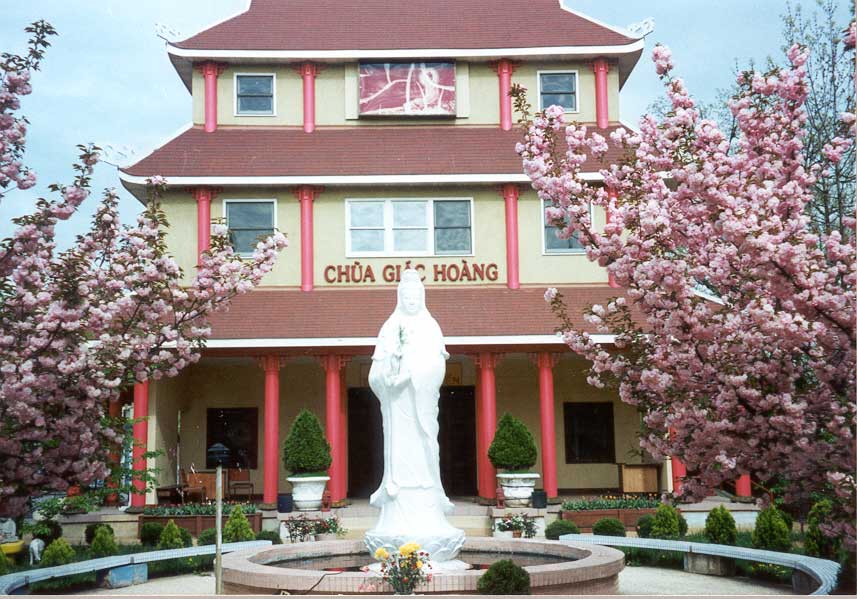|
The same Sunday I visited the Theravada Buddhist Vihara in Northwest Washington, D.C. I also happened to visit a Vietnamese Buddhist Temple a little further north up the block. My co-worker Shan had told me about this temple. He said we could walk there on foot. We crossed over Colorado Avenue with Rock Creek Park on our left. This temple was distinctly different than the Buddhist Vihara. Instead of a single-family home with a small front yard, steps led up from the sidewalk to a courtyard framed by a large Asian gateway arch. It looked very out of place amid the neighboring buildings. Beyond the archway was a large square building with a dark-brown roof. Immediately after walking through the archway, there was a fountain with a large statue of Kuan Yin in the middle. She was holding a carafe or pitcher pointing downward and it appeared that this potentially was a fountain that could spew water. I remembered reading about her in our textbook and related some background to Shan, who had never heard of her before. The pool contained many lotus flowers, which I found very beautiful. Directly in front of the building on a small patio was both a "happy" or smiling Buddha (as in the Chinese Good Luck symbol) as well as a meditating Buddha statue. Off to the right of the porch, sort of enclosing the area, was a large painting of Kuan Yin with "supplicants" surrounding her.
There were several people milling about and we could see a group of children and adolescents with some musical instruments and what appeared to be part of a Dragon costume off to the left of the building. There was a large set of wooden double doors but we couldn't open them. As were trying to determine how to gain access to the building, one of the kids told us to use the side entrance on the left. I asked him why there were two statues and he simply said that the happy Buddha was for "good luck" and encouraged us to rub the statue's belly. Same as in the Theravada temple, we took off our shoes upon entering. This room was entirely different from the other temple. There were some chairs lined up in rows towards the front of the building. The room was paneled in what appeared to be some kind of dark wood. The windows were set high in the wall, almost directly under the roofline. This made the room appear dim. Many small pictures of what looked like Buddha were displayed high on the walls. At the far end, flowers surrounded a large statue of Buddha. In front of the statue was a high altar full of offering. The green-glazed Chinese dragons on either side of the altar captured my attention. Pyramids of what appeared to be either sugar cones wrapped in brightly colored cellophane or butter sculptures were stacked on trays. In addition to some candles, there was also incense. In the background, I could hear instrumental music, which sounded like traditional Chinese music (bamboo flute, etc.) Shan asked me if I liked the music and when I said yes, he said that this was beneficial for meditation. Since there were no other people about, we stood in silence while contemplating the scene in front of us. This Buddha statue was displayed making a sacred mudra, where his right hand is lifted up instead of resting in his lap. It was very peaceful inside the building. Although this temple looked completely different than the Vihara, it did not strike me as a "rich" looking temple. I had hoped that I could ask someone for more details, but no one besides my co-worker and myself were in the building. As we were getting ready to leave, some of the children we had seen earlier came into the room. They were dressed in what appeared to be some sort of Boy Scout outfits. To be honest, I could not discern any girls among the children. They all faced the altar in formation and then someone began to bang a drum. We wanted to move out of the way, but were told that there was no need to move. However, we did move off to one side of the room, since the groups seemed to be engaging in some kind of prayer ritual. When we stepped outside, the people that I had seen earlier were not in the courtyard anymore. I speculated that maybe those people were leaving a ceremony that had concluded as we walked up. I found it curious and sad that there wasn't a single monk to be seen. I did ask my co-worker if his temple and this congregation had ever shared in a joint ceremony or gathering and he said 'no'. I remembered that we had discussed this separateness between different Buddhist communities in class and was surprised that this would even hold true for two communities in such close proximity of each other. As was pointed out to me in class, I now realize that this is a Zen/Pure Land Buddhist temple, which does not practice Theravada Buddhism. I've been trying to locate this particular temple online, but can't find a website or link for it. I'm half-tempted to drive down 16th street again to attend an actual ceremony at this temple because it did seem a bit more remote and foreign to me. |
| Created by Laura Ellen Shulman |
Last updated: October 2002
|
